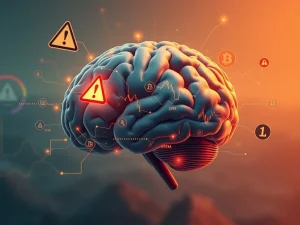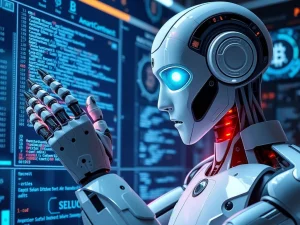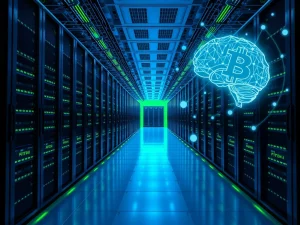Microsoft AI: Unveiling a Pivotal, Challenging Strategic Shift with 15,000 Job Cuts

In the rapidly evolving digital landscape, where innovation dictates survival, major shifts in tech giants often send ripples across the entire ecosystem – including the burgeoning world of cryptocurrencies. Microsoft, a titan of technology, has recently made headlines with a significant strategic move: cutting approximately 15,000 jobs to aggressively pivot towards Microsoft AI investments. While seemingly distant from the daily swings of Bitcoin or Ethereum, these monumental decisions by industry leaders signal a profound reallocation of resources and talent, hinting at the next frontier of technological advancement that could indirectly shape the future of decentralized technologies. Understanding these shifts helps us gauge the broader currents of innovation and capital flow in the digital economy.
The Unfolding Reality of Tech Layoffs: A Global Trend?
Microsoft CEO Satya Nadella has publicly acknowledged the profound emotional and operational impact of the company’s recent workforce reductions, describing them as among the most challenging decisions of his leadership. This year alone, Microsoft has cut nearly 15,000 jobs, with a significant portion—9,000—announced in July. While the company maintains that its total workforce remains ‘relatively unchanged’ due to ongoing hiring in other critical areas, the concentration of these cuts in specific departments indicates a deliberate restructuring rather than a simple headcount adjustment.
Nadella framed these extensive tech layoffs as a necessary step to reallocate resources. This strategic maneuver aims to sharpen Microsoft’s competitive edge in a rapidly evolving technological landscape, particularly as the race for AI dominance intensifies. He described the situation as an ‘enigma of success,’ highlighting the tension between Microsoft’s record profitability and the imperative to streamline operations for long-term growth. This paradox reflects a broader trend seen across the tech industry, where even highly successful companies are re-evaluating their structures to better align with future growth areas, primarily AI.
The human element of these decisions has not gone unnoticed. In internal memos, Nadella conveyed that the job cuts have ‘weighed heavily’ on him and the leadership team, acknowledging the personal and organizational toll. Despite the difficult nature of these decisions, he expressed confidence that a restructured workforce would enable Microsoft to ‘shape, lead through, and have greater agility’ in the AI era. However, he also cautioned that further reductions could occur as market demands continue to shift, underscoring the dynamic and sometimes volatile nature of the tech sector.
Why is Microsoft Making These AI Investments?
Microsoft’s aggressive pivot towards AI is not just a reactive measure but a proactive strategy to dominate the next wave of technological innovation. The company’s commitment is underscored by an astounding $80 billion allocated for AI investments in 2025. This substantial financial commitment highlights the perceived criticality of AI in shaping future products, services, and market leadership.
Analysts widely link these significant layoffs and resource reallocations to a broader trend within the tech industry. Companies are restructuring their operations to prioritize and accelerate AI development, recognizing it as a foundational technology for future growth. For Microsoft, this means moving beyond traditional software provision to becoming an ‘intelligence engine’ – a platform that empowers users to build their own AI-driven solutions, rather than just offering tools for specific tasks.
The vision is clear: by embedding AI capabilities deeply into its ecosystem, Microsoft aims to create more intuitive, powerful, and adaptive products. This involves:
- Enhancing Existing Products: Integrating AI into Office 365, Azure, and other core offerings to boost productivity and efficiency.
- Developing New AI-Native Solutions: Creating entirely new services and platforms built from the ground up with AI at their core.
- Investing in Research and Development: Funding cutting-edge AI research to maintain a leading position in areas like large language models, machine learning, and computer vision.
- Talent Acquisition and Reskilling: While some roles are eliminated, there’s a simultaneous push to hire new AI specialists and reskill existing employees to meet the demands of this new era.
This strategic focus on AI is about securing long-term competitive advantage and ensuring Microsoft remains at the forefront of technological progress.
Navigating the Strategic Shift: Satya Nadella‘s Vision
Satya Nadella, as CEO, is the architect of this significant strategic shift. His communications emphasize a delicate balance: acknowledging the pain of job cuts while articulating a compelling vision for Microsoft’s future. He has reiterated Microsoft’s long-standing mission to ’empower people and organizations to achieve more,’ adapting it to the realities of the AI era. This adaptation involves a fundamental change in how Microsoft perceives its role in the tech ecosystem.
Nadella envisions Microsoft evolving from a traditional software provider to a pervasive ‘intelligence engine.’ This means a shift from merely developing tools for specific tasks to creating platforms that enable users to build their own solutions, leveraging AI’s transformative power. This vision aligns with the goal of fostering a more agile and responsive organization capable of leading through the rapid changes brought by AI.
The mixed messaging around workforce stability has drawn scrutiny. While Microsoft reports its overall headcount remains stable, the concentration of layoffs in specific departments suggests a deliberate, surgical restructuring. This approach is common in tech companies undergoing significant digital transformation, where efficiency gains in one area are used to fund innovation and growth in another. Nadella’s acknowledgment of the emotional toll highlights the complexity of balancing short-term financial gains with long-term strategic goals—a challenge shared by many leaders in the industry.
His leadership during this period reflects a broader narrative in tech, where executives must navigate the tension between business imperatives and ethical considerations. The coming months will be crucial in determining whether these strategic moves translate into sustained success, enhanced agility, and a revitalized corporate culture, or if they amplify existing challenges in workforce engagement and market perception.
The Human Cost and Future of Microsoft AI
While the strategic imperative behind Microsoft’s AI pivot is clear, the human cost of these large-scale changes is significant. The tech layoffs have sparked mixed reactions, highlighting a common dilemma in corporate restructuring: balancing innovation with employee welfare.
Some view the move as a pragmatic response to market pressures, necessary for long-term survival and growth. Others, however, criticize the human cost, pointing to the potential for a disconnect between stated corporate values and difficult business decisions. A former Microsoft director, for instance, reportedly criticized the layoffs as a betrayal of employee loyalty, arguing that the company’s stated values did not align with its decision-making. Social media platforms also reflected widespread disappointment and emotional strain among workers affected by the changes.
For those remaining, the challenge lies in adapting to a restructured environment while maintaining morale and productivity. The success of Microsoft’s aggressive push into Microsoft AI will depend not only on technological breakthroughs but also on its ability to foster an environment where employees feel valued, despite the difficult changes. The company’s ability to enhance agility and maintain employee morale will be critical. The emphasis on necessity and difficulty of these decisions by Nadella reflects a common challenge for tech leaders: how to communicate and execute painful but strategically vital changes while preserving the core of their workforce and culture.
Microsoft’s recent job cuts, driven by a profound strategic shift towards AI investments, represent a pivotal moment not just for the company, but for the broader tech industry. CEO Satya Nadella’s navigation of this ‘enigma of success’ – balancing record profitability with significant workforce reductions – underscores the relentless pace of innovation and the competitive pressures defining the digital age. While the immediate impact of tech layoffs is felt deeply by individuals, the long-term vision aims to solidify Microsoft’s position as a leading ‘intelligence engine’ in the era of Microsoft AI. The success of this ambitious strategic shift hinges on both technological prowess and the ability to maintain a resilient, engaged workforce, setting a precedent for how tech giants adapt to future challenges and opportunities.
Frequently Asked Questions (FAQs)
1. How many jobs did Microsoft cut recently?
Microsoft has cut nearly 15,000 jobs this year, with 9,000 of those announced in July alone, as part of a strategic restructuring.
2. Why is Microsoft cutting jobs despite record profitability?
Microsoft is cutting jobs as part of a strategic shift to reallocate resources and prioritize massive investments in AI initiatives. CEO Satya Nadella described it as an ‘enigma of success,’ aiming to streamline operations for long-term growth and competitive advantage in the AI era.
3. What is Satya Nadella’s vision for Microsoft’s future?
Satya Nadella envisions Microsoft evolving into an ‘intelligence engine,’ moving beyond traditional software provision to creating platforms that empower users to build their own AI-driven solutions. He emphasizes agility, innovation, and maintaining Microsoft’s competitive edge in the AI era.
4. What is Microsoft’s financial commitment to AI?
Microsoft has committed a significant $80 billion towards AI investments for 2025, underscoring the company’s strong belief in AI as the future of technology.
5. How do these major tech shifts impact the broader digital economy, including cryptocurrencies?
Major strategic shifts by tech giants like Microsoft, especially towards AI, signal where significant capital and talent are flowing. This can influence the broader digital economy by setting new standards for innovation, impacting the demand for skilled tech workers, and indirectly shaping the infrastructure and applications that decentralized technologies (like cryptocurrencies and blockchain) might interact with or build upon in the future. It highlights a focus on foundational technologies that could underpin the next generation of digital advancements.









